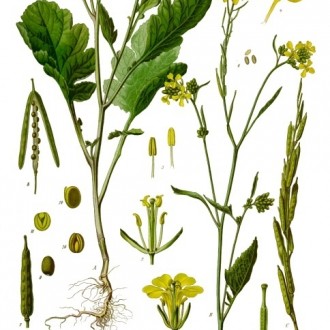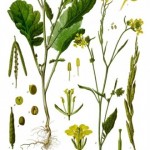We are interested in a wide number of topics including the evolutionary biology of phenotypic plasticity, the ecology and genetics of floral evolution, the effects of pollinator diversity on plant reproduction, the speciation process, the functionality of pollination networks, etc.

Phenotypic plasticity – causes, mechanisms, evolutionary effects
The phenotypic plasticity (PP) is the ability of some genotypes to produce different phenotypes when faced with different environmental conditions. All genotypes alter aspects of their phenotype when the environment varies. Still, the phenotypic response to large climatic variations is especially crucial for organisms that cannot move spatially, such as plants. In some instances, plasticity can be functional, allowing organisms to successfully cope with environmental changes through acclimatization, and can even be adaptive if accompanied by an increase in fitness. Thus, the ability of an organism to respond to or also anticipate environmental changes is crucial to its reproductive success and survival.
Project ADAPMAR
The adaptive value of multivariate phenotypic plasticity in Moricandia arvensis: from genes to ecology

How organisms adapt to changing environments is a central question in ecology and evolution. Phenotypic plasticity, the ability of a genotype to produce alternative phenotypes when exposed to different environments, is a pervasive response of most organisms when facing varying conditions. Plastic responses of organisms are often active in order to avoid any reduction in fitness. This adaptive plasticity allows organisms to cope successfully with environmental changes. Although fundamental to understanding how plasticity evolves, demonstrating adaptive plasticity remains elusive. In this subproject, we use as model system Moricandia arvensis to investigate the adaptive value of the multivariate within-individual phenotypic plasticity (MWIP). This unique plant species responds to the two contrasting climatic conditions where it grows, mild and wet during spring but extremely dry and hot during summer, by exhibiting within-individual plasticity for many traits grouped in at least five functional groups (flower, leaf economics spectrum, photosynthetic metabolism, life history, and plant defenses). In particular, we will explore the ecological causes and limits as well as the genetic/epigenetic mechanisms triggering the MWIP. Among the latter, we will explore the role of differential gene expression, gene co-expression networks, alternative splicing, and small RNAs in the phenotypic plasticity elicited by contrasting environmental conditions. We will also analyze the role of methylation patterns in the expression of MWIP by producing whole genome methylomes to know which genic regions are affected by the methylation marks associated with the MWIP. We will also explore how antagonistic organisms, insect herbivores, elicit within-individual plasticity in some chemical defenses and determine whether this response varies in the spring and summer seasons. We will also evaluate whether herbivore-induced plasticity disrupts plant-pollinator interaction in both seasons. Afterward, we will determine how the optimal expression of plasticity in response to the abiotic environment can be impaired by the existence of certain limits imposed by the stress caused by herbivores. Linking the ecological and genetic part of this subproject, we will identify the differentially expressed genes associated with the herbivore-induced plastic response of the plant and whether this transcriptomic response caused by the herbivore damage vary between spring and summer conditions. Finally, we will explore whether herbivores modulate the systemic response of the transcriptome to the different environments. Altogether, our interdisciplinary project will contribute to filling important gaps in the theory of phenotypic plasticity.
Project evoMOR
Evolution of phenotypic plasticity in the genus Moricandia

In previous projects we have detected that Moricandia arvensis, a common plant in Andalusian agricultural areas, exhibits phenotypic plasticity for flowers, such that in spring it produces large, pigmented and dissymmetric flowers while in summer it produces white, small and rounded flowers. This is associated with a change in its pollination niche. In this project we will study the adaptive value of such plasticity, its genetic basis, its role in determining the colonizing nature of the species and finally explore how phenotypic plasticity has evolved throughout the genus Moricandia. We will determine the adaptive value of plasticity in Moricandia arvensis in floral (corolla and corolla tube size, petal pigmentation, corolla shape) and functional traits (specific leaf area, leaf dry mass, photosynthetic metabolism), studying the selection regimes that influence them. In addition, the importance of phenotypic plasticity of M. arvensis, which seems to have favored its ability to colonize new geographical areas with different environments, will be studied through field studies in different regions (native, introduced archaeophyte and introduced neophyte) of the current distribution area of the species, which will shed light on the presence of genetic accommodation. We will experimentally study whether non-plastic congeneric species under natural conditions can exhibit plasticity when forced to flower under different environmental conditions. Finally, we will analyze the genotype x environment interaction and the genetic regulatory networks that modulate phenotypic plasticity in this genus, including Iberian and African species that show different levels of plasticity. In this way we will be able to detect the existence of cryptic phenotypic plasticity and the possibility that a phenomenon of genetic assimilation has occurred throughout the evolutionary history of the genus. The global information obtained from this project will allow us to determine the real role that phenotypic plasticity has played in the ability of M. arvensis to spread throughout the Mediterranean and its ability to cope with a scenario of climate change. This information could be useful to know the real capacity of the plants to face the anthropogenic effects derived from global change.
Project MORE
Phenotypic plasticity as a evolutionary driver in Moricandia

In this project, we analyzed the genetic basis of a extreme case of phenotypic plasticity in some species of genus Moricandia (Brassicaceae), how it expresses in functional and floral traits, and its importance to understanding the ecology and evolution of this plant genus.
Four species inhabit the Iberian Peninsula: three endemic (M. rytidocarpoides, M. foetida, M. moricandioides) and one circum-Mediterranean (M. arvensis). This last species occurs in agricultural, ruderal, and disturbed habitats from south and east of the peninsula, M. moricandioides occurs in semi-deserts from eastern Spain, and the other two species are narrow-endemic desert species from SE Spain. The three Spanish species bloom during a short period during late winter or spring, whereas M. arvensis has an extended flowering spanning from late winter to summer and even autumn. We think that these differences in distribution and flowering phenology are a consequence, at least partially, of the phenotypic plasticity in functional traits displayed by M. arvensis. We also think that an effect of this functional plasticity is the presence of phenotypic plasticity in floral traits and pollination niches.
Moricandia arvensis, contrasting with the other congeneric species, exhibits ample plasticity in floral traits. Whereas spring flowers are large, cross-shaped, and lilac -similar to those of M. moricandioides-, summer flowers are small, rounded, and white -similar to those of the two desert species-. We will determine the genetic basis of this plasticity by studying the effect of environmental factors in gene expression and analyzing regulatory gene networks. We will also explore the impact of these factors in the phenotypic expression by quantifying the reaction norms of floral traits in the field and in experimental conditions.
More info

Evolutionary ecology of invasive species
Project EXTINCTION
Hidden Extinctions: Losing plant diversity in Iberian arid zones as a consequence of the anthropic-mediated expansion of weeds

In this project, funded by the Fundación BBVA (PR17-ECO-0021), we evaluate the consequences of the expansion of weeds associated to human environments on the arid vegetation from the Iberian Peninsula. The specific goal is to check whether the presence of the ruderal species Moricandia arvensis is having a harmful effect on its three co-generic species endemic to arid habitats, namely, M. moricandioides, M. foetida and M. rytidocarpoides.
More info
Project INVASION
Brassica nigra as a model for plant invasions

There are increased interests in studies of invasive species due to possibilities of some invaders having strong negative impacts on natives. We are presently using Brassica nigra (Brassicaceae), a native of the Mediterranean region, as a model plant to investigate ecological and evolutionary mechanisms that enable it to invade North and South America.
More info
Macro- and micro-evolution of plant-pollinators interactions
 Flower form is widely considered as an adaptation to increase the interaction with the most efficient pollinators, expressing both at microevolutionary (flower form affects plant fitness) and macroevolutionary level (inter-specific differences in flower form correlated to differences in pollinator assemblage). More info
Flower form is widely considered as an adaptation to increase the interaction with the most efficient pollinators, expressing both at microevolutionary (flower form affects plant fitness) and macroevolutionary level (inter-specific differences in flower form correlated to differences in pollinator assemblage). More info
The Geographic Mosaic Theory of Coevolution is a central theory in evolutionary biology nowadays. Most information, however, comes from specialized organisms. In contrast, an accurate understanding of the effect of geographically varying evolutionary dynamics on the evolution of generalist organisms is lacking, although these organisms are the most frequent in nature. Our lab is currently working in the consequences of the spatial variation in selective regimes for the occurrence of geographic mosaic in generalized pollination systems.
The role of biological diversity in maintaining ecosystem functioning is a central issue in ecology and conservation. Most studies on diversity-functioning relationships have focused on ecosystem and community levels, but a challenging and still unsolved issue is determining whether it can be generalized to other organization levels, such as populations and individuals. In our lab we are currently exploring this question both from an experimental and a theoretical perspective. More info
Project UNIGEN
Evolution in Generalist Universes

The main goal of this project is to investigate how species evolve and lineages diversify as a consequence of generalist ecological interactions. For getting this aim, we will focus in one mage-generalist interaction, the pollination interaction between Brassicaceae species and their floral visitors, focusing on Iberian species.
More info
Project STRUGEN
Structured Generalization: evolutionary dynamics at fine spatial scales in a generalist system

The main aim of this project is to explore the occurrence of pollinator-mediated structured generalization, the factors favoring or cancelling it, and their potential evolutionary and functional consequences.
More info
Speciation
Pollinators can drive adaptive speciation in some plant groups. Accurately determining the role of pollinators in mediating plant speciation requires an integrated approach where microevolutionary studies focusing on the analysis of pollinator-mediated selection be complemented with macroevolutionary studies exploring the evolution of floral traits between phylogenetically-related species. In our lab, we are using this inclusive approach in order to investigate the possibility of pollination-driven speciation in Erysimum.
Project PREGEPES
Ecological and genetic processes producing speciation (PREGEPES)
 Ecological and genetic processes producing speciation: the interplay between hybridization, poliploidy, and local adaptation in generalist plants. PREGEPES is a scientific project funded by the Ministerio de Economía y Competitividad.
Ecological and genetic processes producing speciation: the interplay between hybridization, poliploidy, and local adaptation in generalist plants. PREGEPES is a scientific project funded by the Ministerio de Economía y Competitividad.
More info
Project SEPARATION
Implementing techniques to species identification in lineages with incomplete separation
The aim of this project is to implement genetic and ecological techniques to the rigorously identification of species in highly diversified groups of taxa (species complex, syngameons).
More info
